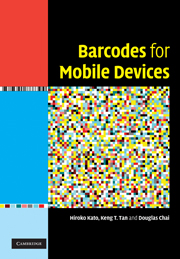Book contents
- Frontmatter
- Contents
- Preface
- 1 Introduction
- 2 Barcode technology evolution
- 3 Two-dimensional barcode for mobile phones
- 4 Evolution of barcode applications
- 5 Technologies for enhancing barcode robustness
- 6 A prototype colour 2D barcode development
- 7 Evaluation of the prototype colour 2D barcode
- Appendices
- References
- Index
- Plate section
5 - Technologies for enhancing barcode robustness
Published online by Cambridge University Press: 06 July 2010
- Frontmatter
- Contents
- Preface
- 1 Introduction
- 2 Barcode technology evolution
- 3 Two-dimensional barcode for mobile phones
- 4 Evolution of barcode applications
- 5 Technologies for enhancing barcode robustness
- 6 A prototype colour 2D barcode development
- 7 Evaluation of the prototype colour 2D barcode
- Appendices
- References
- Index
- Plate section
Summary
One of the advantages of barcode technology is its fast, accurate and reliable operation. Most one-dimensional (1D) barcodes only use a checksum to ensure that the data are correctly decoded. The data of 1D barcodes are vertically redundant. This allows correct data retrieval even when the symbol has been partially damaged. When at least one horizontal path across the barcode is readable, a code with printing defects can be correctly read. Furthermore, human-readable characters are also printed below most 1D barcodes (see Figure 2.12). This allows users to input the data manually in the worst-case scenario. Hence, a checksum for error detection may be sufficient for a 1D barcode.
Moreover, two-dimensional (2D) barcodes do not have such vertical redundancy. Furthermore, they are not accompanied by human-readable characters, often because of the limitation in printing area for the data encoded in 2D barcodes. Printing the encoded data near the symbol may be possible when using index 2D barcodes with limited data capacity. However, considering the space efficiency advantage of 2D barcodes, it is reasonable not to print human-readable characters along with the 2D barcode symbols. In some cases, it might be impossible owing to space restrictions. This prevents users from correcting data manually if an error should occur. Hence, 2D barcodes need a means of not only detecting errors but also correcting them.
Error detection and correction codes
Among the many error detection and/or correction techniques, the one most commonly used for 2D barcodes is the Reed–Solomon code. Nearly all database 2D barcodes have adopted this technique.
- Type
- Chapter
- Information
- Barcodes for Mobile Devices , pp. 130 - 151Publisher: Cambridge University PressPrint publication year: 2010



